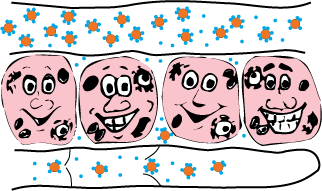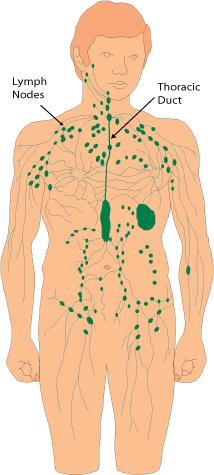Stay Informed
Popular Articles
- Hiatal Hernia: Hidden Cause of Chronic Illness
- Small Intestinal Bacterial Overgrowth (SIBO)
- Applied Lymphology: Unlocking the Secret to Pain Relief
- An Introduction to Constitutional Iridology
- The Low Down on Liver Detoxification
- An Energetic and Emotional Approach to Cancer
- Fat Facts
- Marrow in the Bones
- Blood Type and Nutrition
- Cardiac Herbs: Beyond Hawthorn
Quick Search
The School of Modern Herbal Medicine




Applied Lymphology: Unlocking the Secret to Pain Relief
- 4/8/2009
- Categorized in: General Health
This is page 1 of a four-part article.
 Before I started working for Nature's Sunshine Products in March of 1984, I spent a full year working with Dr. C. Samuel West and his International Academy of Lymphology. For those of you who never met Dr. West, he was a dynamic crusader determined to spread the word about the “gospel” of lymphology. (He is a perfect example of someone who needs blue vervain flower essence—look it up sometime and you'll see what I mean.) His classes were like revival meetings dedicated to spreading the “good word” about healing the body via the lymphatic system. He is best-known for his promotion of “lymphasing” or rebound exercise on a mini-trampoline.
Before I started working for Nature's Sunshine Products in March of 1984, I spent a full year working with Dr. C. Samuel West and his International Academy of Lymphology. For those of you who never met Dr. West, he was a dynamic crusader determined to spread the word about the “gospel” of lymphology. (He is a perfect example of someone who needs blue vervain flower essence—look it up sometime and you'll see what I mean.) His classes were like revival meetings dedicated to spreading the “good word” about healing the body via the lymphatic system. He is best-known for his promotion of “lymphasing” or rebound exercise on a mini-trampoline.
The most important thing I gained from working with Dr. West was the knowledge of how to relieve pain. Using the principles I learned from that pioneer in applied lymphology, I have been able to relieve the pain of smashed fingers, bumps, bruises, burns, swellings, sore throats, earaches and more in relatively short periods of time—anywhere from a few minutes to a maximum of about one hour. Understanding what causes pain and how it can be relieved has also given me unique insights into the disease process in general, and how herbs work to correct it.
Understanding our Lymphatics
To begin with, we all realize that our bodies are composed of billions of cells. Each cell must receive a constant flow of oxygen and nutrients. This nourishment is transported via the bloodstream.
Water is held in the bloodstream by means of osmotic pressure. Large molecules of three different proteins (albumin, globulin and fibrinogen) attract water and prevent it from leaking out of the pores in the blood vessels. Under normal conditions these proteins are too large to leave the circulatory system, but the pressure in the arterial end of the capillaries is great enough to force some these proteins, albumin in particular, through the membranes and into the tissue spaces. With this protein comes some of the plasma (the fluid portion of the blood) which carries with it dissolved nutrients and oxygen.
Once this plasma has left the blood stream, it is called lymph. Lymph bathes every cell in the body. It is the great internal ocean that all of our cells live in. These lymphatic fluids are the biological terrain or internal environment of our body. The cells draw their nourishment from this lymphatic ocean and release their waste products back into it. This is why the lymphatic fluid must be kept constantly flowing. Fresh, nutrient-laden lymph fluid must be brought in as toxin-laden lymph fluid must be flushed away.
On the venous end of the capillary, there is a drop in pressure. This allows osmosis to passively draw some of the lymphatic fluid back into the blood stream. However, there is no pressure in the spaces around the cells to force the water-attracting albumin back into the blood stream. So some of the albumin and the fluid attached to it is left behind.
If this fluid were allowed to accumulate, the internal environment would become swampy, resulting in decreased oxygen and nutrients to the cells and increased retention of toxic waste. So removal of this protein and fluid is vital to cellular health, and that is where the lymphatics come into play.
The only way for this fluid and albumin to return to the blood stream is via the lymphatics. The lymphatic system is the other half of our circulatory system. It may help to think of the circulatory system as the water pipes that bring fresh water to your home and the lymphatic system as the sewer or septic system that drains away the waste water. This analogy can also be helpful in understanding that the blood is pumped through the vessels under pressure, just like your water supply is pressurized. The lymphatic system, however, does not have a pump. It is a passive, non-pressurized system, like your drain pipes.
The figure below shows what I like to call “happy cells,” that is, cells which have a proper supply of oxygen and nutrients via the bloodstream and a healthy drainage of excess fluid via the lymphatic system. The reddish colored dots represent the plasma proteins and the blue dots the water molecules. The vessel at the top is a blood capillary, the one at the bottom is a lymphatic capillary.

How the Lymphatics Work
The lymphatics originate in the tissue spaces with tiny lymphatic capillaries which then drain into small lymphatic vessels. These in turn join together into larger lymphatic ducts. We might compare this to a watershed on a mountain range. The lymphatic capillaries are like numerous small springs scattered over a mountainside. These feed into small streams, which merge and flow into larger streams until they join into one big river.
The lymphatic “river” is the thoracic duct, located in our upper chest. Most lymphatic fluid drains into this duct, which empties its contents into the blood stream at the subclavian vein at the base of the neck. The remainder of the lymph drains into a smaller duct on the opposite side of the body.
Like the watershed or the sewer system, the water in the lymphatic stream does not go “uphill” against the current. The lymphatics flow in one direction, away from the tissues and back to the chest and bloodstream. The flow in this passive system is created by a combination of muscular activity, tissue compression, deep breathing, elasticity of the lymphatic vessels and one-way check valves. The one-way valves ensure that movement is always forward and not backward.
Deep breathing greatly increases lymphatic flow because it pumps the thoracic duct. However, movement of the body is the most powerful lymphatic pumping mechanism. Exercise increases lymph flow as much as five to fifteen times.
Understanding the passive movement in the lymphatic system explains why we feel a little stiff and sore after a prolonged period of sitting. Lack of movement slows lymphatic flow, which causes albumin and fluid to accumulate in the spaces around our cells. This diminishes oxygen and nutrient exchange, so the cells begin to complain by sending mild pain signals.
How do we respond to this? We may feel like stretching, yawning or rubbing the part that is sore. All of these activities pump lymphatic fluid, thereby diminishing fluid buildup around the cells and increasing oxygen and nutrient exchange. As a result, the cells quit complaining.
Here is an illustration of the lymphatic system showing the main lymphatic vessels and lymph nodes.

